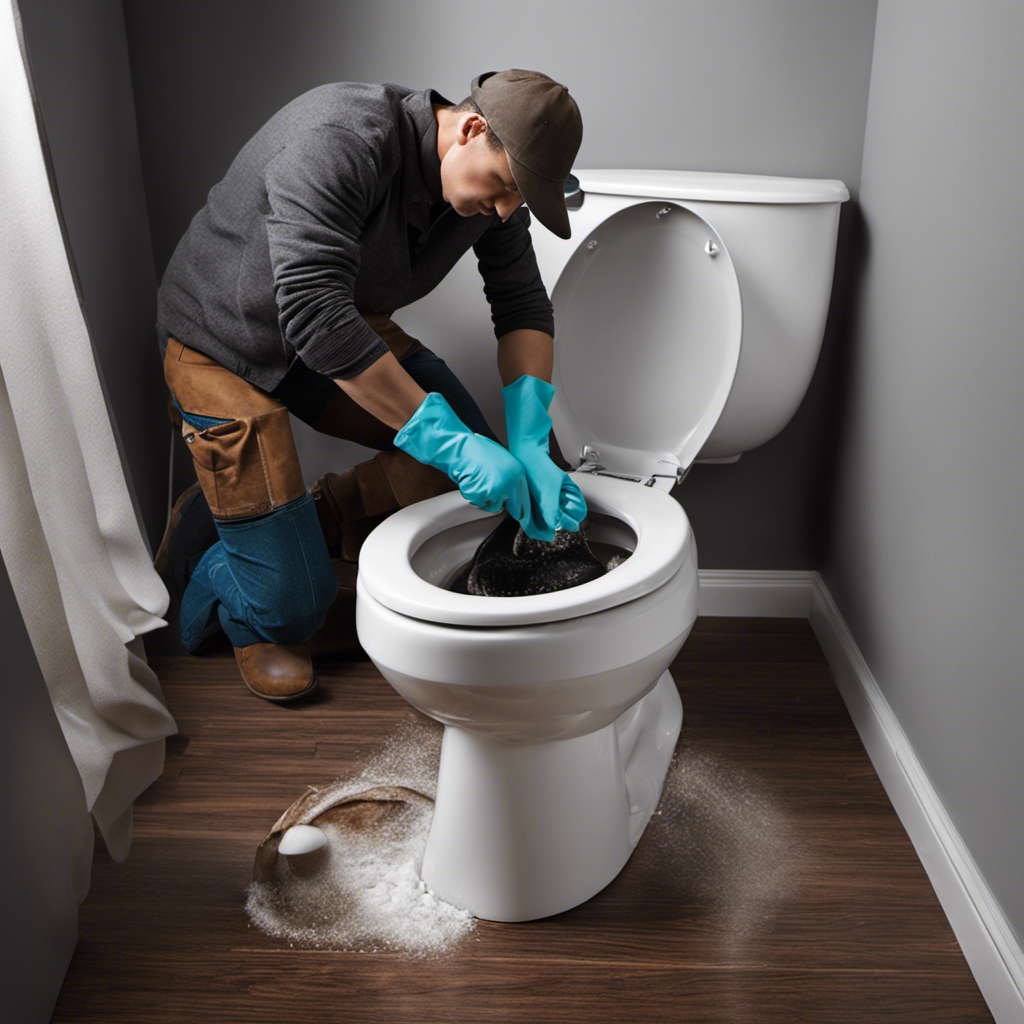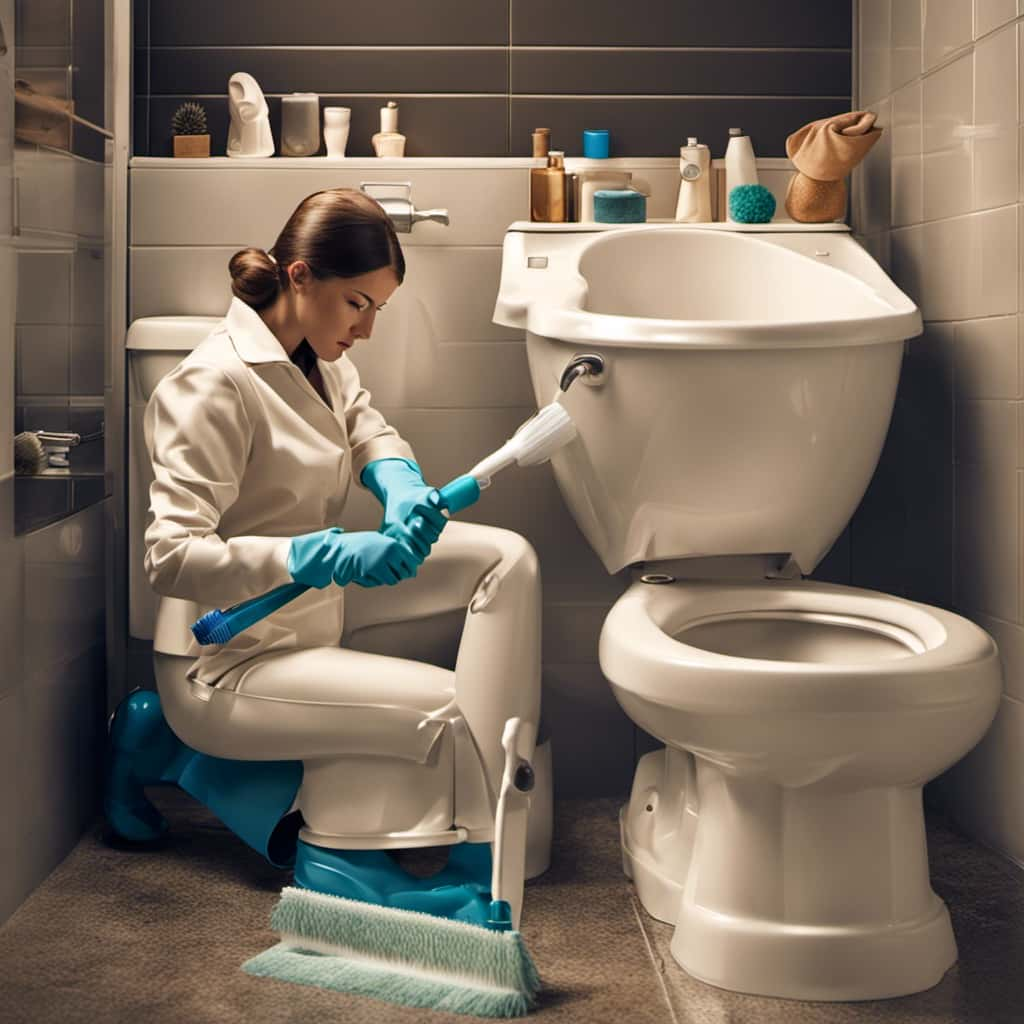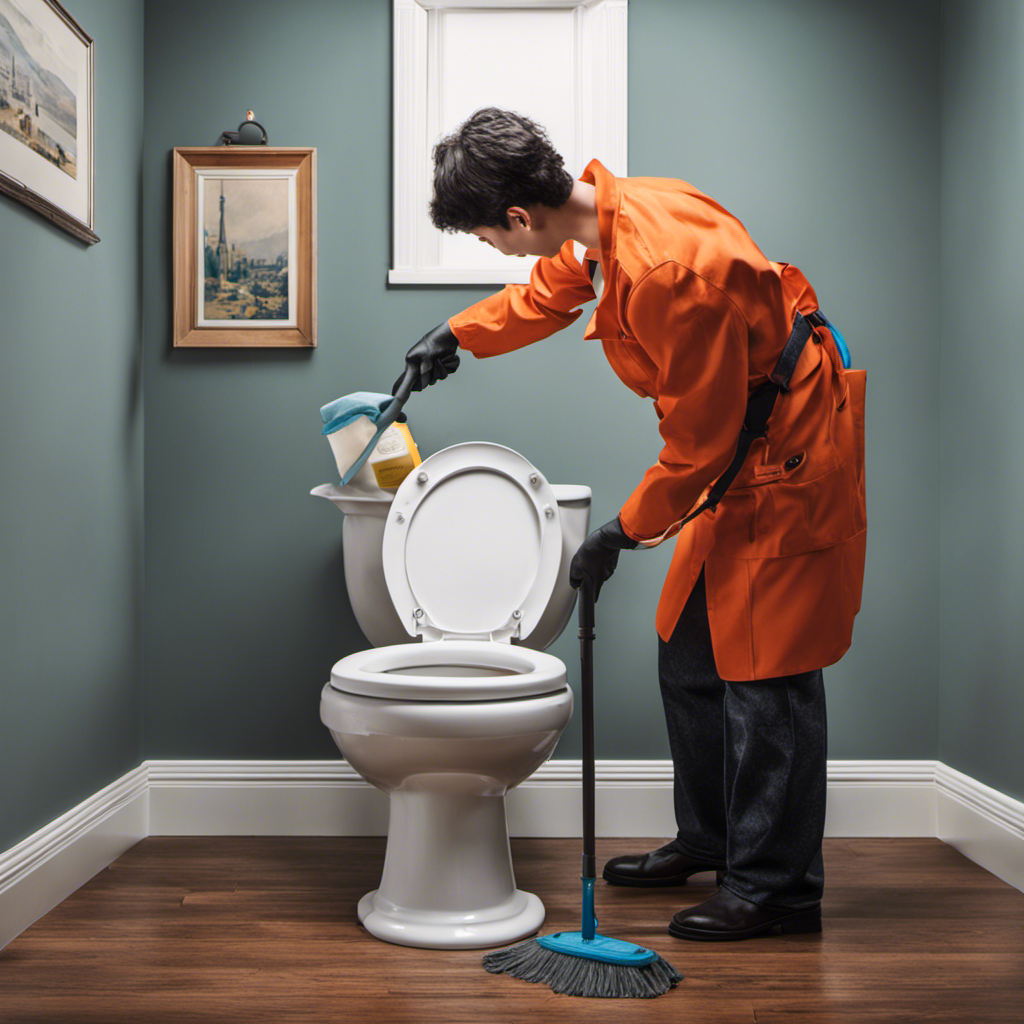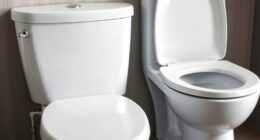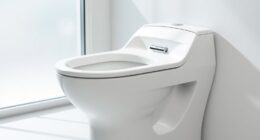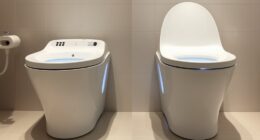Hey folks, ever found yourself in a messy situation with a toilet that just won’t stop clogging up? Well, fear not! In this article, I’m going to share some tried-and-true methods to fix that pesky problem once and for all.
We’ll dive into the common causes of toilet clogs, assess water flow and pressure, clear obstructions, and even examine and replace the flapper valve if needed.
So, grab your tools and let’s get that toilet running smoothly again!
Key Takeaways
- Common causes of toilet clogs include excessive toilet paper, low water pressure, foreign objects, hard water deposits, and tree roots invading the sewer line.
- To assess water flow and pressure, check the shut-off valve, inspect the fill valve and flush valve for obstructions, examine the water supply line for kinks or leaks, and ensure proper water pressure.
- Clear obstructions in the toilet bowl by using a plunger or a toilet auger, following proper techniques to avoid further damage, and seeking professional help if necessary.
- Prevent future clogs by being mindful of what goes down the toilet, regularly maintaining the toilet with enzyme-based drain cleaners, periodically snaking the toilet, educating household members on proper usage, and keeping the plunger and toilet clean.
Common Causes of Toilet Clogs
One common cause of toilet clogs is when you flush excessive amounts of toilet paper at once. It’s important to be mindful of the amount you’re flushing to avoid any potential issues.
Another factor to consider is the water pressure in your toilet. Assessing water pressure is crucial because if it’s too low, it may not be able to effectively clear toilet obstructions. In such cases, you may need to adjust the water pressure or seek professional help to fix the problem.
Clearing toilet obstructions is a necessary step in preventing clogs. Using a plunger or a toilet auger can effectively remove any blockages. Remember to follow the proper techniques to avoid causing further damage.
Assessing Water Flow and Pressure
Check if you’re getting enough water flow and pressure in your toilet. Proper water flow and pressure are crucial for the efficient functioning of your toilet. If you’re experiencing clogs, it’s essential to assess the water pressure to identify any underlying issues.
Here are three steps to troubleshoot water flow and pressure:
-
Check the shut-off valve: Ensure that the shut-off valve, located behind or near the toilet, is fully open. If it’s partially closed, it can restrict water flow and result in inadequate pressure.
-
Remove any obstructions: Inspect the toilet’s fill valve and flush valve for any obstructions or debris. Clean or replace these components as necessary to improve water flow.
-
Assess the water supply line: Examine the water supply line for any kinks, twists, or leaks. Straighten or replace the line if needed to maintain proper water pressure.
Clearing Obstructions in the Toilet Bowl
When it comes to clearing obstructions in the toilet bowl, there are a couple of effective methods that I can recommend.
First, you can try using a plunger to unclog the toilet. Make sure to create a good seal around the drain and use a strong, forceful motion to dislodge the blockage.
If that doesn’t work, another option is to use a toilet auger, which is a long, flexible tool designed specifically for clearing stubborn clogs. Insert the auger into the toilet bowl and crank the handle to break up and remove the obstruction.
Unclogging With Plunger
To unclog the toilet with a plunger, start by creating a tight seal around the drain hole. This will ensure that the pressure from the plunging action is focused on clearing the blockages effectively.
Here are some troubleshooting techniques to follow:
- Position the plunger over the drain hole, making sure it covers the entire area.
- Push down forcefully and then pull up quickly. Repeat this motion several times to create suction and dislodge the blockage.
- If the water level is too high, you can remove some of it using a bucket or a cup before plunging.
Remember to be patient and persistent with the plunging process. If the blockage persists, it may be necessary to try other methods or seek professional help.
Using a Toilet Auger
Using a toilet auger can be an effective way to clear stubborn blockages in the drain. To ensure proper functioning, regular maintenance is crucial. After each use, it’s important to clean the auger thoroughly to remove any debris. Additionally, inspect the auger for signs of damage or wear, such as bent or dull blades.
Troubleshooting toilet auger usage involves ensuring the cable is fully inserted into the drain and rotating it clockwise while applying gentle pressure. If the blockage persists, try adjusting the angle or applying more pressure. However, if the toilet auger fails to clear the clog, it may be necessary to utilize other methods, such as plungers, to resolve the issue.
Utilizing Toilet Augers and Plungers
When it comes to dealing with stubborn clogs in the toilet, it’s essential to have the right tools and know how to use them effectively.
One of the most effective tools for clearing clogs is a toilet auger, also known as a snake. By inserting the auger into the toilet drain and turning the handle, you can break up and remove the clog.
Another important tool is a plunger, which can be used to create pressure and suction to dislodge the clog. It’s crucial to use proper plunging techniques, such as creating a tight seal around the drain and using firm, rhythmic movements.
Finally, to prevent future clogs, it’s important to be mindful of what goes down the toilet. Avoid flushing items that can easily cause clogs, such as feminine hygiene products, wipes, and excessive amounts of toilet paper.
Regular maintenance, such as using enzyme-based drain cleaners and periodically snaking the toilet, can also help prevent clogs from occurring.
Using Toilet Augers Effectively
You’ll want to position the toilet auger’s cable inside the drain opening. This is crucial for effective unclogging.
Here are some important tips for using a toilet auger effectively:
-
Proper Cable Insertion: Make sure to insert the cable slowly and steadily into the drain opening, ensuring it goes as far as possible.
-
Rotate and Push: Once the cable is inserted, rotate it in a clockwise motion while pushing it further into the drain. This helps to break up any clogs and clear the obstruction.
-
Retract and Repeat: After rotating and pushing, retract the cable slowly while continuing to rotate. This action helps to pull out any debris or clogs. Repeat the process if necessary until the toilet is completely unclogged.
Proper Plunger Techniques
Now that we’ve covered how to effectively use a toilet auger, let’s move on to proper plunger techniques.
It’s important to not only know how to use a plunger correctly but also how to store and maintain it.
When it comes to plunger storage, it’s crucial to keep it in a clean and dry area. This will help prevent any contamination or damage that could render the plunger ineffective. I recommend finding a spot in your bathroom where it can be easily accessed in case of emergencies.
In terms of maintenance, regularly cleaning your plunger is essential. After each use, rinse it with hot water and a disinfectant to remove any bacteria. Additionally, make sure to inspect the rubber cup for any signs of wear and tear. If you notice any cracks or damage, it’s time to replace your plunger.
Preventing Future Clogs
To avoid future clogs, it’s important to be mindful of what you flush down the toilet. Here are some tips to help you maintain your toilet and prevent clogs:
-
Regular toilet maintenance: Make it a habit to clean your toilet regularly to prevent any build-up of debris or residue that could potentially cause clogs.
-
Proper waste disposal: Avoid flushing items such as wipes, feminine hygiene products, paper towels, or anything other than toilet paper and human waste. These items can easily cause blockages in your toilet drain.
-
Drain cleaning methods: If you notice slow draining or recurring clogs, you can use drain cleaning methods such as using a plunger or a drain snake to clear any minor obstructions.
By following these simple steps, you can minimize the risk of future clogs and keep your toilet running smoothly.
Now, let’s move on to examining and replacing the flapper valve.
Examining and Replacing the Flapper Valve
If the flapper valve is damaged, it may need to be replaced to fix a toilet that keeps clogging up. The flapper valve is a crucial component of the toilet flush system. It is responsible for sealing the tank and allowing water to flow into the bowl when the flush lever is pressed. Over time, the flapper valve can deteriorate or become misaligned, leading to a weak or incomplete flush. To troubleshoot the toilet flush, start by inspecting the flapper valve. Look for signs of wear, such as cracks or warping. If any damage is found, it is recommended to replace the flapper valve. Here is a table to help you understand the steps involved in replacing the toilet flapper:
| Steps to Replace Toilet Flapper | Tools Needed |
|---|---|
| 1. Shut off water supply to toilet | Adjustable wrench |
| 2. Drain water from tank | Bucket |
| 3. Remove old flapper valve | Screwdriver |
| 4. Install new flapper valve | New flapper valve |
| 5. Turn on water supply and test flush | Water supply valve, Flush lever |
Preventive Measures to Avoid Future Clogs
To prevent future clogs, you should make sure to dispose of items like wipes and feminine products in a trash can instead of flushing them down the toilet. Flushing improper items can lead to blockages and costly repairs.
In addition to proper disposal, there are a few other preventive measures you can take to maintain your toilet and avoid future clogs:
- Regularly clean the rim and jets of the toilet bowl to remove any mineral deposits or buildup that can restrict water flow.
- Use a plunger to clear minor clogs before they become major issues. Apply firm pressure and create a tight seal around the drain to maximize effectiveness.
- Consider installing a drain screen or filter to catch debris before it enters the toilet drain, reducing the risk of clogs.
When to Seek Professional Plumbing Help
When your toilet continues to have persistent clogs despite your best efforts, it may be time to seek professional plumbing help. While DIY toilet repairs can solve many common issues, there are certain situations where professional assistance is necessary. Plumbing emergencies such as overflowing toilets, sewage backups, or stubborn clogs deep within the plumbing system require the expertise of a licensed plumber. Attempting to fix these problems yourself can lead to further damage and costly repairs. To help determine when it’s time to call in the professionals, consider the following scenarios:
| Plumbing Emergencies | DIY Toilet Repairs |
|---|---|
| Overflowing toilet | Clogged trap |
| Sewage backup | Blocked pipe |
| Persistent clogs | Faulty flapper |
| Leaking toilet base or tank | Loose connections |
Conclusion
In conclusion, fixing a toilet that keeps clogging up can be a frustrating task. However, with the right knowledge and tools, it can be manageable.
One way to approach the issue is by assessing water flow and pressure. Sometimes, a toilet may clog due to low water pressure or a problem with the water supply. By checking these factors, you can determine if they are contributing to the clogging issue.
Another step to take is clearing obstructions. Often, a clogged toilet is caused by a blockage in the pipes. This can be due to items such as toilet paper, sanitary products, or even foreign objects accidentally flushed down the toilet. By using a plunger or a toilet auger, you can attempt to clear the blockage and restore proper flushing.
Examining the flapper valve is also important. A malfunctioning flapper valve can cause the toilet to clog. By inspecting and cleaning the flapper valve, you can ensure that it is functioning properly and allowing water to flow smoothly.
For example, I once had a toilet that constantly clogged due to a buildup of mineral deposits in the pipes. After using a toilet auger to clear the blockage, the problem was resolved, and the toilet has been running smoothly ever since.
It is crucial to take preventive measures to avoid future clogs. This includes not flushing items that are not meant to be flushed, such as wipes or paper towels. Additionally, regular maintenance, such as using a toilet bowl cleaner or vinegar to remove mineral deposits, can help prevent clogs from occurring.
However, if you have tried these steps and the toilet continues to clog, it may be time to seek professional help. A plumber can assess the situation and determine if there are underlying issues with the plumbing system that need to be addressed.
In conclusion, fixing a toilet that keeps clogging up can be frustrating, but by following these steps and taking preventive measures, you can often solve the issue yourself. Remember to know when to seek professional help if needed.
